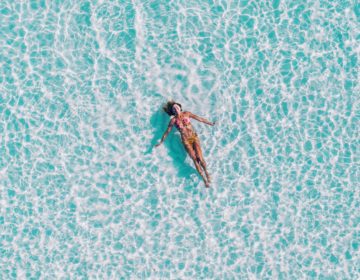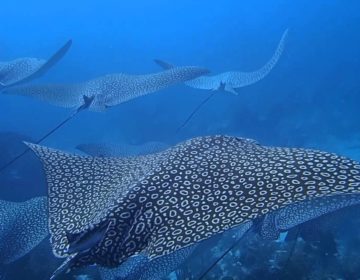“Turtles were of such a size that the shell of one would suffice to roof a little hut or cot and to cover ten or more persons sitting. There were vast numbers of them at the Maldives and some little islands you may see inhabited by no other animals than these great turtles, but covered with them.”
Francois Pyrard, Voyages, 1602 – 1607
Five of the seven known species of turtles in the world are seen in the Maldives. All turtles have a robust horny beak; none have real teeth. They use paddle-shaped flippers to propel themselves to speeds of up to 35km per hour. During the nesting season females return to land to lay their eggs in a nest dug into the sandy beach. After around two months the hatchlings go back to the sea. Turtles live long lives – thought to be up to 50 years and can survive long periods without food.
Marine turtles are the living representatives of a group of reptiles that has existed on Earth and traveled our seas for the last 100 million years. They are a fundamental link in marine ecosystems. Leatherback turtles consume large numbers of jellyfish which helps to keep populations of these marine organisms in check. Marine turtles, including leatherbacks, also provide a vital source of income as a draw for ecotourism in coastal communities, especially in the Coral Triangle. (www.worldwildlife.org)

Interesting Sea Turtle Facts
- Sea turtles have been swimming in the oceans for much longer than humans have walked the earth. They have been around for the last 100 million years.
- To reach their nesting grounds, sea turtles migrate long distances every 2-4 years, traveling back to the very same beaches where they were born.
- Anywhere between 60-200 eggs are laid at a time and take two months to hatch. After hatching, baby turtles must crawl as fast as they can to the water and avoid a multitude of predators.
Hawksbill Sea Turtle (Eretmochelys imbricata)
Hawksbill turtles can be found in tropical and subtropical regions of the Atlantic, Pacific, and Indian Oceans and the species is widely distributed in the Caribbean Sea and the western Atlantic Ocean. In contrast to all other sea turtle species, Hawksbills nest in low densities on small, scattered beaches.
Hawksbill turtles are the most commonly seen turtle along the reefs of the Maldives. This small to medium-sized marine turtle has a beautifully colored shell which serves as an effective camouflage in coral reefs. The thin elongated oval shell has overlapping scutes on the carapace, and the turtle has a relatively small head with a distinctive hawk-like beak, and flippers with two claws.
They measure up to 91 cm and weigh between 113 and 182 kg and are easily identified by a ‘beak-like’ upper jaw that resembles a hawk’s bill. Hawksbill turtles are mainly carnivorous and appear to be opportunistic predators, using their narrow beaks to extract invertebrate prey from crevices on the reef. They also feed on algae, sea grasses, barnacles, fish, and sponges.
 Hawksbill turtles are the most commonly seen turtle along the reefs of the Maldives.
Hawksbill turtles are the most commonly seen turtle along the reefs of the Maldives.
Population
A recent estimate of the global population size of Hawksbill Turtles has been made, and it is thought that there are only five populations worldwide with more than 1,000 females nesting annually (World Wildlife Fund).
Major Threats
Hawksbills face multiple, severe threats including the Tortoiseshell Trade, egg collection, slaughter for meat, destructing of nesting and foraging habitat, oil pollution, entanglement and ingestion of marine debris and fishing gear and hybridization of Hawksbills with other species. In 2001 an International Union for the Conservation of Nature (IUCN) Red List Subcommittee upheld the Critically Endangered listing of the Hawksbill based on ongoing and long-term declines more than 80% within three generations. Hawksbill Turtles can take 20 to 40 years to mature. Data on reproductive longevity in Hawksbills are limited, but becoming available with increasing numbers of intensively monitored, long-term projects on protected beaches. (WWF)
Interesting Hawksbill Sea Turtle Facts
- The Hawksbill Turtle is one of the smallest species of turtle and sadly also the most endangered. Their beautiful gold and brown patterned shells are hunted and sold illegally on the black market – often used to create ornamental products.
- The Hawksbill is the only sea turtle with a combination of two pairs of prefrontal scales on the head and four pairs of costal scutes on the carapace. This carapace is unusual among marine turtles as the scutes (the hard, bony plates that constitute the shell) are overlapping.
- The Hawksbill Turtle is omnivorous. Much like a bird of prey, their narrow, pointed beak is a specialized feeding tool and allows the turtle to reach into small cracks in the coral reef to extract sponges and other invertebrates.
- Coral reef sponges are the Hawksbills primary source of food – a food source which is toxic to most animals due to the spicules they contain. The Hawksbill turtle is immune, and this type of feeding provides a service to other marine life by contributing to the health of coral reefs and marine life. (http://wildlifeact.com)
Green Sea Turtle (Chelonia mydas)
Green sea turtles, also known as black (sea) turtles or Pacific green turtles, are one of the largest sea turtles and the only herbivore among the different species. Named for the greenish color of their cartilage and fat, as opposed to the color of their shells, which can also sometimes be black. Green turtles are found mainly in tropical and subtropical waters, with two distinct populations in the Atlantic and Pacific Oceans, and some in the Indian Ocean.
This species is predominantly vegetarian, feeding mostly on algae and sea grasses and can hold their breath for hours at a time. They usually inhabit shallow lagoons, feeding mainly on various species of sea grasses, biting off the tips of the blades of sea grass, which keeps the grass healthy.
These turtles can grow to lengths of up to 100 cm and weigh between 113 and 182 kg, and like other species of sea turtles, they migrate long distances between feeding grounds and the beaches from where they hatched. Many islands worldwide are known as Turtle Island due to green sea turtles nesting on their shores. Females crawl out on beaches, dig nests and lay eggs during the night. Later, hatchlings emerge and scramble into the water. Those that reach maturity may live to 80 years in the wild. (WWF)
 Green sea turtles, also known as black (sea) turtles or Pacific green turtles, are one of the largest sea turtles.
Green sea turtles, also known as black (sea) turtles or Pacific green turtles, are one of the largest sea turtles.
Major Threats
Classified as endangered by the IUCN and CITES, green turtles are threatened by over-harvesting of their eggs, hunting of adults, being caught in fishing gear and loss of nesting beach sites. Pollution indirectly harms turtles at both population and individual scales, as well as light pollution, and real estate development, which often causes habitat loss by eliminating nesting beaches. The species is protected from exploitation in most countries, and it is illegal to collect, harm or kill them. In addition, many countries have laws and ordinances to protect nesting areas. (WWF)
Loggerhead Sea Turtle (Caretta caretta)
Loggerhead sea turtles (Caretta caretta), or loggerheads, are so named due to their overly large heads with a horny beak that is significantly thicker than in other sea turtles. This species is the largest hard-shelled turtle in the world and have skin that ranges from yellow to brown, shells that are typically reddish brown with darker streaks, and front flippers that possess two claws. The average loggerhead measures around 90 cm long when fully grown, although larger specimens of up to 280 cm have been discovered and weigh approximately 135 kg, with the largest specimens weighing in at more than 450 kilograms.
The loggerhead sea turtle is found in the Atlantic, Indian and Pacific, as well as the Mediterranean Sea and spends most of its life in saltwater and estuarine habitats, with females briefly coming ashore to lay eggs. Female loggerhead sea turtles lay an average of four egg clutches and then become quiescent, producing no eggs for two to three years. The loggerhead has a lifespan of 47–67 years. The loggerhead sea turtle is omnivorous, has powerful jaws and feed mainly on bottom-dwelling invertebrates such as shellfish, sponges, and jellyfish.
 Loggerhead sea turtles are so named due to their overly large heads with a horny beak that is significantly thicker than in other sea turtles.
Loggerhead sea turtles are so named due to their overly large heads with a horny beak that is significantly thicker than in other sea turtles.
Major Threats
Loggerheads are considered a vulnerable species by the IUCN. Commercial trade of loggerheads or derived products is prohibited by CITES, but untended fishing gear is responsible for many loggerhead deaths as turtles suffocate if they are trapped in fishing trawls. Loss of suitable nesting beaches and the introduction of exotic predators have also taken a toll on loggerhead populations. Efforts to restore their numbers will require international cooperation since the turtles roam vast areas of ocean and critical nesting beaches are scattered across several countries. (WWF)
Olive Ridley Sea Turtles (Lepidochelys olivacea)
Olive ridley sea turtles, also known as the Pacific ridley sea turtles, are the smallest and most abundant of all sea turtles found in the world. Found in warm and tropical waters, primarily in the Pacific and Indian Oceans, these turtles are best known for their unique mass nesting called arribada, where thousands of females come together on the same beach to lay eggs.
The olive ridley turtle is closely related to the Kemp’s ridley turtle and is named for the generally greenish color of its skin and shell or carapace. Olive and Kemp’s ridley turtles only reach about only about two feet in shell length and weigh between 36 and 41 kg.
The olive ridley is mostly carnivorous, feeding on such creatures as jellyfish, snails, crabs, and shrimp, but will occasionally eat algae and seaweed as well. Hatchlings, most of which perish before reaching the ocean, are preyed on by crabs, raccoons, pigs, snakes, and birds, among others and adults are often taken by sharks.
 The olive ridley is mostly carnivorous, feeding on such creatures as jellyfish, snails, crabs, and shrimp.
The olive ridley is mostly carnivorous, feeding on such creatures as jellyfish, snails, crabs, and shrimp.
Major Threats
The olive ridley turtle is classified as vulnerable or threatened according to the International Union for Conservation of Nature and Natural Resources (IUCN), and is listed in Appendix I of CITES. Though the olive ridley is widely considered the most abundant of the marine turtles, by all estimates, it is in trouble and its numbers, particularly in the western Atlantic, have declined precipitously. Many governments have protections for olive ridleys, but still, eggs are taken, and nesting females are slaughtered for their meat and skin. Fishing nets also take a significant toll, frequently snagging and drowning these turtles.
The species has experienced large-scale commercial exploitation and trade for their skins, however the Convention on Migratory Species and the Inter-American Convention for the Protection and Conservation of Sea Turtles have also provided olive ridleys with protection, leading to increased conservation and management for this marine turtle. (National Geographic)
Leatherback Sea Turtles (Dermochelys coricea)
Leatherback sea turtles are the largest of the turtle species. Named for their shell, which is leather-like rather than hard, like other turtles and has five ridges that run the length of the shell, leatherback sea turtles are one of the most migratory, crossing both the Atlantic and Pacific Oceans. Pacific leatherbacks migrate from nesting beaches in the Coral Triangle all the way to the California coast to feed on the abundant jellyfish every summer and fall.
 Leatherback turtles have severely declined during the last century as a result of intense egg collection and fisheries by-catch.
Leatherback turtles have severely declined during the last century as a result of intense egg collection and fisheries by-catch.
Major Threats
Although their distribution is broad, numbers of leatherback turtles have severely declined during the last century as a result of intense egg collection and fisheries bycatch. Pacific populations have declined over the last twenty years from over-harvesting and interactions with fisheries. Atlantic leatherbacks, with their long migrations across the ocean, put them at significant risk of running into longline fisheries. Leatherbacks feed almost exclusively on jellyfish, making them susceptible to mistakenly swallowing plastic bags floating in the ocean, which can kill them. Globally, leatherback status according to ICUN is listed as vulnerable, but many sub-populations (such as in the Pacific and Southwest Atlantic) are critically endangered.
Over-Harvesting and Illegal Trade
Egg collection on many turtle nesting beaches is a grave threat, especially in Southeast Asia where a culture of legal egg collection leads to the removal of tens of thousands of eggs. This practice has contributed to the local extinction of leatherbacks in Malaysia. Within the last several decades, extensive egg collection and the killing of adult turtles in Indonesia has resulted in substantial population declines throughout the region. Despite protective legislation, many eggs produced each year in Central America are still collected for subsistence or commercial use. Hunting and egg collection persists throughout the Indian Ocean as well. (https://www.worldwildlife.org/species/leatherback-turtle)
 Egg collection on many turtle nesting beaches is a grave threat.
Egg collection on many turtle nesting beaches is a grave threat.
The Turtle Shell Industry in the Maldives
Turtle shell has always been a major export in the Maldives. It was traded with Arabia, India, and China and greatly sought after by kings, lords and the rich. It was made into boxes and caskets garnished with gold and silver and into bracelets, hair combs, and other ornaments. Turtle products are still snapped up by buyers everywhere, and with the advent of the tourism industry into the Maldives, the wholesale slaughter of turtles for their precious shell has led to a serious decline in their numbers. Turtle flesh and eggs are also sought-after foods and as habitats become invaded by humans, so too does the survival of the species become threatened. The abundant turtles Pyrard saw – “of such size to roof a little hut”- were most probably the loggerhead or leatherback turtle. Where are these turtles today? Divers rarely see leatherback turtles anymore. Tourists are now being made aware that their purchases of jewelry or gifts made from turtle shell is a threat to the turtle population.

Sources: World Wildlife Fund WWF – https://www.worldwildlife.org/; http://wildlifeact.com; International Union for Conservation of Nature and Natural Resources (IUCN); The Convention on International Trade in Endangered Species of Wild Fauna and Flora (CITES); National Geographic



